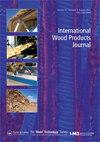The environmental and social impacts of modified wood production: effect of timber sourcing
IF 0.9
Q2 MATERIALS SCIENCE, PAPER & WOOD
引用次数: 1
Abstract
ABSTRACT This study assesses the environmental and social impacts of a modified softwood produced using radiata pine sourced from New Zealand or Chile. The LCA found that differing forestry and transport burdens associated with each location broadly cancelled each other out, giving overall product footprints that were very similar. Boiler gas and phenol-formaldehyde resin were the biggest emitters of GHG emissions, and normalization highlighted toxicity impacts as significant, largely due to the resin input. SLCA hotspots analyses suggest that the forestry sector in Chile has more potential social risks than the equivalent sector in New Zealand. However, each sector scored poorly in different social aspects making it difficult to recommend a sector without introducing subjective judgements. Combining LCA with SLCA is still novel, but this study found it added useful insights into a broader range of impacts associated with sustainable production, especially given the similarity of the environmental LCA results taken alone.改性木材生产的环境和社会影响:木材来源的影响
摘要本研究评估了使用新西兰或智利辐射松生产的改性软木对环境和社会的影响。LCA发现,与每个地点相关的不同林业和运输负担大体上相互抵消,总体产品足迹非常相似。锅炉煤气和酚醛树脂是温室气体排放量最大的国家,标准化强调了毒性影响的严重性,这主要是由于树脂的投入。SLCA热点分析表明,智利林业部门比新西兰同等部门具有更大的潜在社会风险。然而,每个部门在不同的社会方面得分都很低,因此很难在不引入主观判断的情况下推荐一个部门。将生命周期评价与SLCA相结合仍然是一项新颖的研究,但本研究发现,它为与可持续生产相关的更广泛的影响提供了有用的见解,特别是考虑到单独得出的环境生命周期评价结果的相似性。
本文章由计算机程序翻译,如有差异,请以英文原文为准。
求助全文
约1分钟内获得全文
求助全文
来源期刊

International Wood Products Journal
MATERIALS SCIENCE, PAPER & WOOD-
CiteScore
2.40
自引率
0.00%
发文量
27
 求助内容:
求助内容: 应助结果提醒方式:
应助结果提醒方式:


